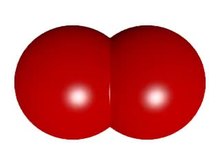Equipotential surface
An equipotential surface , also equipotential surface or potential surface , is the set of all points with the same ( Latin : aequalis) potential , i.e. with the same potential energy of a test body in a potential field . This surface is always perpendicular to the field lines and is a special case of isosurfaces .
The course of the potential field in 2D is often represented with the help of equipotential isolines .
Electrical potential
Here it is a surface whose points all have the same electrical potential . The voltage U between two points of an equipotential surface is thus zero. The electrical work to be done to move a charge carrier from one point on the equipotential surface to another point on the same equipotential surface is also zero.
With static fields, ideal conductors are exactly (with sufficiently low frequencies: almost) equipotential surfaces, as any potential difference would be compensated very quickly due to the infinitely high conductivity . In the case of metals (very high, but finite conductivity), the electrical charges can also move freely. Only if they have no strength, i. H. are not exposed to any field strength , they are in equilibrium. They follow an emerging field very quickly until the field is compensated. It follows from this that (apart from such mostly short-term imbalances) the potential has the same value everywhere (inside and on the surface of a conductor). For a detailed discussion see Faraday cage .
Gravity potential
Here the equipotential surface ( level surface , on earth also geopotential surface) is a surface whose points all have the same (effective) gravitational potential and whose gradient (spatial change) is called gravitational acceleration .
In the case of a rotating celestial body , the equipotential surfaces of gravity are therefore usually not parallel to the surface: at the poles of the celestial body, for example, the effective acceleration due to gravity is greater than at its equator , which is why the equipotential surfaces at the equator are higher than at a point on the pole. But differences in density inside the celestial body also lead to deformations of its gravity field.
The geoid is the equipotential surface of the earth's gravitational field at mean sea level , i.e. all points that have the same geopotential , composed of the gravitational potential and the centrifugal potential at the relevant location. Orthometric heights use these geopotential surfaces to define heights .
The term is used analogously in meteorology , where the term refers to the level surfaces of the same pressure in the atmosphere , which are also subject to the gravitational field. In practice, main pressure areas have been defined (1000, 500, 200 hPa and others).
Surface tension
Due to the surface tension, liquids form equipotential surfaces (ideal under weightlessness).


